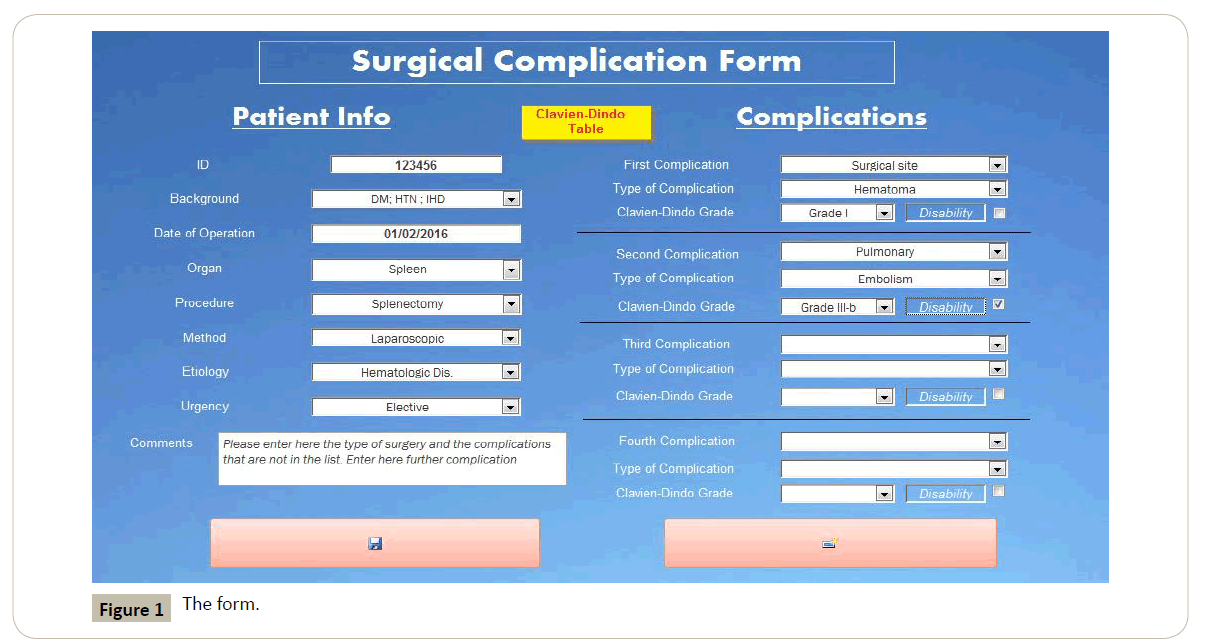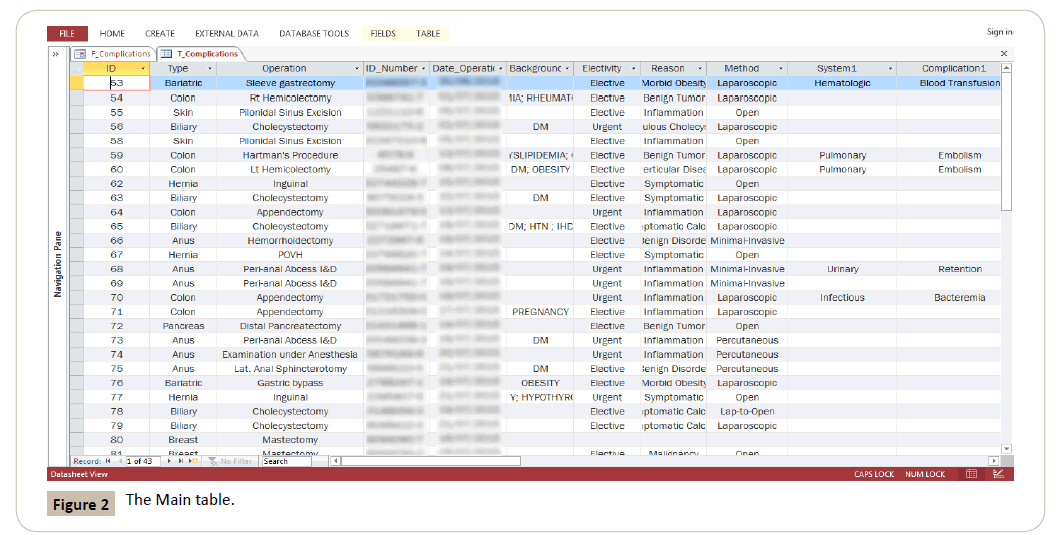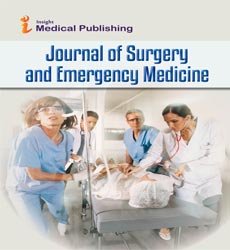Surgical Complications Database: Surgical Database Designed by Surgeons for Surgeons
Department of Surgery, Ziv Medical Center, Safed, Israel
- *Corresponding Author:
- Fedidat R
Department of Surgery
Ziv Medical Center
Safed, Israel
Tel: +972-4682-8811
E-mail: fadida@hadassah.org.il
Received date: December 05, 2018; Accepted date: December 12, 2018; Published date: December 19, 2018
Citation: Fedidat R (2018) Surgical Complications Database: Surgical Database Designed by Surgeons for Surgeons. J Surgery Emerg Med Vol.2 No.2:21
Abstract
The recording of morbidity and mortality amongst surgical in-patients in departments of Surgery is universal. Yet, the collection of accurate data for review, discussion and research is frequently retrospective and may even be at the last minute in preparation for departmental Morbidity and Mortality meetings. The surgical team at Ziv Medical Center has designed a database for the real time recording of complications which utilizes the Clavien-Dindo classification and grading system. This enables surgical outcome to be compared with national and international data and for data to be easily retrieved. The database was designed and constructed from first principles by a surgical resident, charged with the responsibility for recording patient data in preparation for weekly departmental Morbidity and Mortality meetings. It is easy to use, has all-on-one page form, has a series of short drop down menus, and is comprehensive in terms of co-morbidity, procedure and complications. Its simplicity has been its success and complications may be recorded in a matter of seconds during or just after ward rounds. Data may be analyzed within the database as well as exported in to Excel. Further applications for the database are being planned as a means for recording data used for research in all aspects of departmental surgical practice (rather than complications only) such as Trauma, cancer resections and procedures for benign disease. The program also has great potential in the daily evaluation of Critically Ill patients.
Background
Ziv medical center is a 350 bed rural hospital, affiliated to Bar- Ilan Faculty of Medicine. It serves the population of upper Galilee and the Golan and includes all surgical specialties except neurosurgery and cardiothoracic surgery. Advanced laparoscopic surgery is instituted at our department since 2014.
Recording complications of each procedure is of paramount importance for continuous improvement in clinical care on surgical wards worldwide. This is reflected in our department in the weekly “Morbidity & Mortality” meeting.
Retrospective collection of data may lead to inaccurate or only partial detail that results in missed findings and leads to poor academic rigor in clinical practice, audit and research. We designed a friendly computerized interface for the real time prospective recording of surgical complications.
The Form
All-In-One unique page form as been developed for data collection Figure 1. The form is based on the Microsoft Access platform. It is secure and accessed only by named clinicians on ward. The interface is user-friendly and mostly made by simple drop-down menus. The data collected is not extensive but include what we need for data processing and article publishing based on literature.
The data entered by the form is stored as Microsoft Access Database Table. The form is divided into "Patient info" at the left and "Complications" at the right.
Patient Data
This category includes all demographic, co-morbidities and procedure-related information. Data is categorized in menus and sub-menus that facilitate data processing and comparison afterwards.
• ID: Identification number that must correlate to a pre-defined format (individualized).
• BACKROUND: Multiple-choices of co-morbidities in a dropdown menu.
• DATE OF OPERATION: Click on the calendar or enter the date manually.
• ORGAN, PROCEDURE: Each procedure is organized by the organ involved and sub-categorized according to the procedure itself.
• METHOD, ETIOLOGY, URGENCY OF SURGERY: For retrieval and comparison purposes.
• COMMENTS: A box that serves occasional users if something is not listed.
Complications
The "Complications" category is made by drop-down menus only. The complications are sub-categorized according to well-known classifications employed in surgical texts and based on Clavien- Dindo [1] grade. A validation box has been added for designing a debilitating complication. A link to the Clavien-Dindo table is present for quick reference.
Buttons
At the bottom of the form we have two simple visual clickable buttons. The left one is for saving the data and the right for adding a new entry.
The Database
The database part of the file is the heart of the program. It includes the "Main table" and other tables. Just the Main Table is accessible for the occasional user. Other ones are hidden and accessible only by the database administrator.
Main Table
This table comprise all the data entered by the form previously presented Figure 2. The data is ranged in lines, each patient having his distinct ID (given sequentially by the program). Each detail of "Patient Info" and "Complications" categories is shown in a different column. The table is fully searchable and a subpopulation query can be easily retrieved by using filters appearing at the top of each column.
This allow us to retrieves data that we want to look at in seconds (eg. comparison of complications between open and laparoscopic colonic surgery) and can be linked to SQL server for multi-center cooperation. Also, the database can be exported to Microsoft Excel or imported by IBM SPSS Statistics for further analysis.
Other Tables
These tables represent the menus and sub-menus of each dropdown menu of the form. They allow the administrator to add a new entry for co-morbidity, procedure-related or complicationrelated data that was not previously included in the file. The "Comments" box in the form are intended to wake attention to the administrator to add a new entry in drop-down menus.
Conclusion
We presented here a friendly simple database interface for surgical complication recording for general surgery in-patients. Easily retrieved data can serve as a department or hospital-based registry. Further applications can be developed in all aspect of surgical practice: trauma scores and prognosis, margin of normal tissue in oncological surgery, change in audition acuity after ENT surgery, and a potential application in the daily evaluation of critically ill patients.
References
Open Access Journals
- Aquaculture & Veterinary Science
- Chemistry & Chemical Sciences
- Clinical Sciences
- Engineering
- General Science
- Genetics & Molecular Biology
- Health Care & Nursing
- Immunology & Microbiology
- Materials Science
- Mathematics & Physics
- Medical Sciences
- Neurology & Psychiatry
- Oncology & Cancer Science
- Pharmaceutical Sciences


